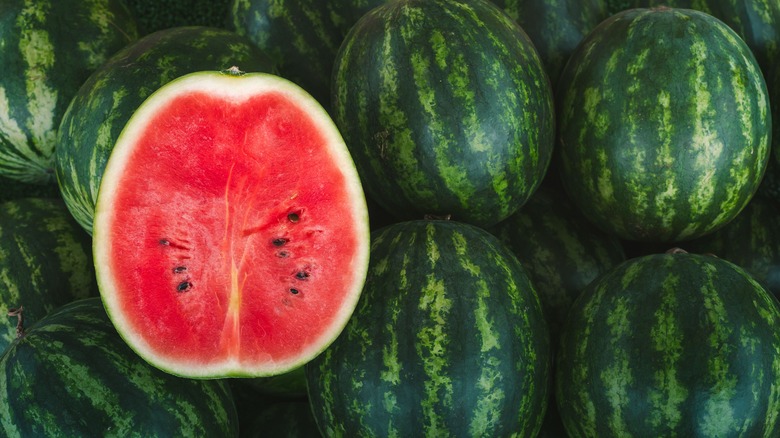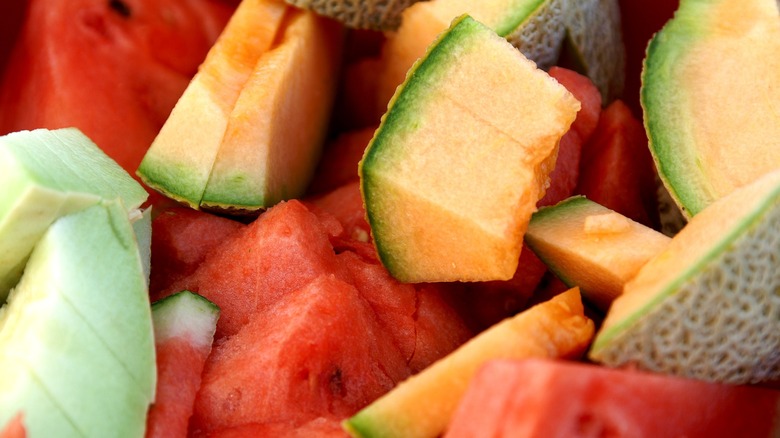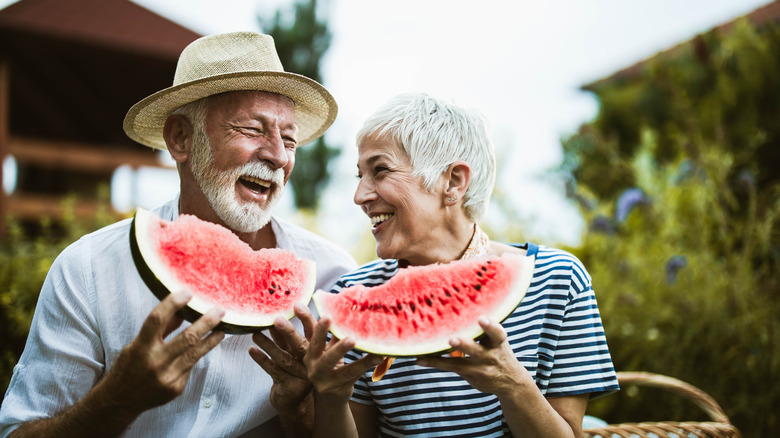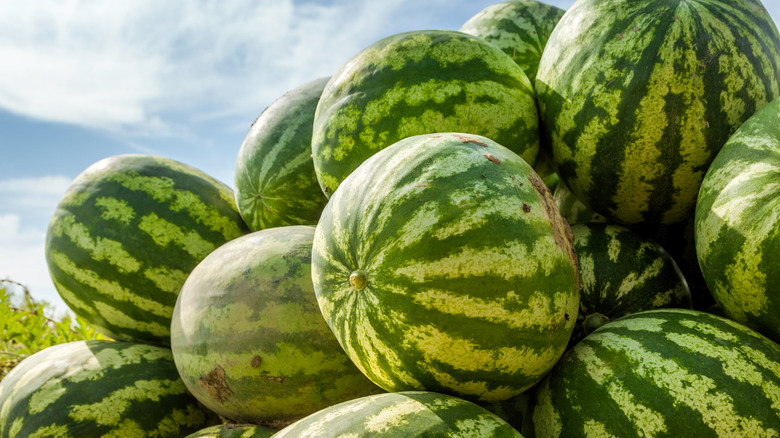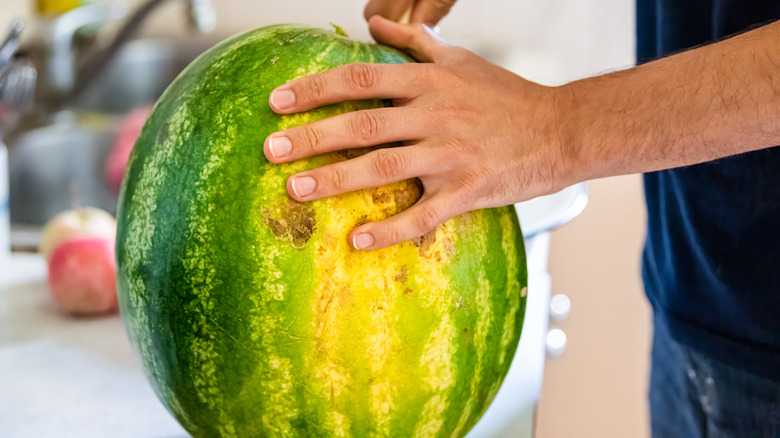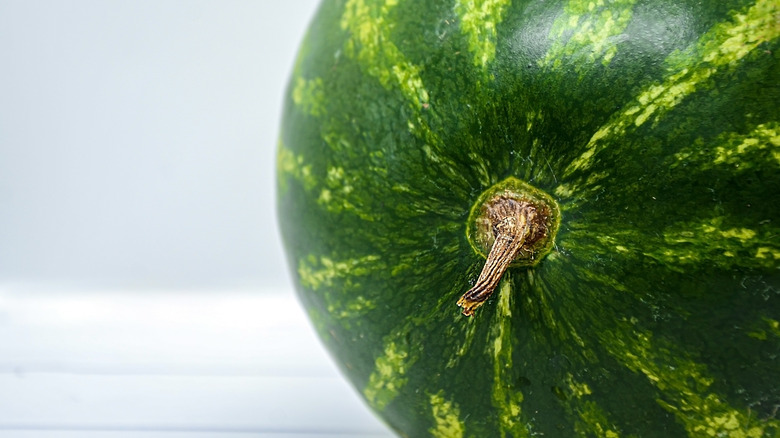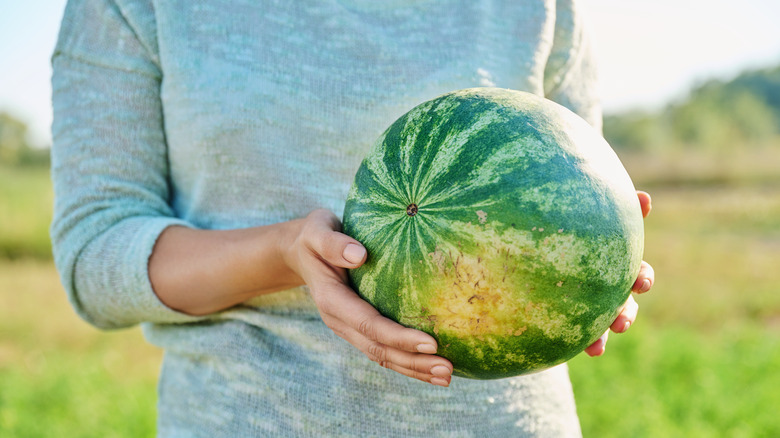How To Pick The Perfect Watermelon
Few things are as quintessentially summer-like as biting into a juicy slice of ripe watermelon. Every year, typically between May and September, fresh watermelons of all varieties pop up at the local grocery store and farmer's markets. Whether you are searching for a classic red-fleshed watermelon, like the Klondike Blue Ribbon Striped, a seedless variety, like the Triple Crown, or yellow-fleshed fruit, like the Tendergold, there is nothing worse than psyching yourself up to dive into one, to discover it is under or overripe.
Short of developing x-ray vision to see through the firm peel of a watermelon, a few tricks and tips exist that you can use to determine if one will be perfectly ripe and delicious or tasteless and mealy. Once you master these, you will be well on your way to discovering the myriad creative ways you can use a watermelon, from refreshing salads to spicy snacks and cocktails. That's why we've created a list of everything you ever needed to know about the whimsical world of watermelons.
What is a watermelon?
The refreshing watermelon, or Citrullus lanatus, is a fruit that is a member of the Cucurbitaceae or gourd botanical family that includes zucchini, cucumbers, and winter squash. Wild watermelons originated in the deserts of South Africa. From there, they spread to North Africa, as is evidenced by Egyptian hieroglyphs dating back 5,000 years. Watermelons spread to China by the 10th century through the Mediterranean before migrating across Europe and beyond in the 13th century.
More than 1,200 varieties exist today, with around 300 different types grown in the U.S. and South America alone. Though the watermelon is predominantly associated with summer, its proliferation across 96 countries globally makes it available in some places year-round. Due to their ease of consumption, seedless varieties are now the dominant cultivar, representing 92% of all watermelon sales. Contrary to popular belief, seedless watermelons are not genetically modified but a sterile hybrid that is a byproduct of cross-breeding.
Where watermelon shines, beyond its versatility in the kitchen, is its nutritional profile. According to Healthline, watermelon has the highest concentration of the antioxidant lycopene and the amino acid citrulline of any fruit or vegetable. These have been linked with myriad health benefits, including blood pressure regulation. Watermelon is also made up of 92% water, which can help prevent dehydration in hot weather and after a strenuous workout.
Watermelon vs. cantaloupe
While watermelon and cantaloupe are traditional summer fruits and members of the same botanical family, they have some notable differences. First, watermelons tend to be larger than cantaloupes on average. Watermelons also tend to have seeds that are sporadically dispersed throughout the flesh of the fruit, whether they are the black ones that are inedible or the white edible ones found in seedless varieties. The seeds in a cantaloupe are concentrated in the center of the fruit. Lastly, the entire watermelon, including the rind, is edible once thoroughly washed. This is not the case for the cantaloupe.
From a nutritional perspective, they are similar in many aspects, including calorie content, carbohydrates, fat, protein, and water content, according to Souper Sage. Cantaloupe has the advantage over watermelon in fiber content, vitamin C, vitamin A, niacin, folate, potassium, beta-carotene, lutein, and Zeaxanthin. Watermelon has an advantage in the lycopene department. Both can be healthy additions to your diet, though they are not necessarily interchangeable nutritionally or from a culinary perspective.
Before you buy a watermelon
Though watermelons can be found year-round in most major grocery stores, these fruits travel long distances before arriving at your local retailer. This makes them more susceptible to damage during transport and less likely to be fully ripe when you purchase it. You're better off reserving your watermelon purchasing and consumption to its peak season, which can run from May to September, depending upon where you live.
Before purchasing a watermelon, determine when you want to eat it. A ripe watermelon will typically last on the countertop at room temperature if untouched for up to a week. Beyond that, it can begin to lose moisture and become mealy. If you plan to buy a watermelon for a summer BBQ or special event, you will want to purchase it within a week of serving it. Depending on how many people you are hosting, you need to determine how large a watermelon to buy. The typical watermelon can weigh up to 20 pounds. This will feed around 30 people if sliced into equal-sized ¾ inch-thick wedges, assuming each person consumes two wedges apiece.
While purchasing pre-sliced watermelon to save time and effort seems tempting, we do not recommend it. Not only is the quality inferior, but sliced melon has an extremely short shelf-life, only three to five days, according to Consumer Reports. Additionally, bacteria can easily be transferred from the rind of a melon into its flesh when it is cut. Without cleaning a melon before it is sliced, bacteria can quickly spread, causing foodborne illness. Always opt for a ripe, whole watermelon.
Look at its coloring
Start evaluating the ripeness of a watermelon by assessing its color and sheen. A ripe watermelon typically has more defined, regularly interspersed stripes along its rind. Striped watermelons will have deeply verdant stripes punctuated by muted, cream-colored ones. Those not striped may be more challenging to evaluate based on color.
Fortunately, there are other measures to determine ripeness, like sheen. A ripe watermelon should not glisten like the morning dew. It should be lackluster, indicating it has had the opportunity to ripen on the vine.
Inspect its field spot
A watermelon's field, ground, or belly spot is the area of the fruit where it used to lay on the earth as it ripened. This part of the watermelon should never be pale-hued. This is a sign that the watermelon was harvested before it was fully ripened.
Because watermelon is not a climacteric fruit, meaning it will not continue to ripen after it has been harvested, those picked from the vine early will never attain a sweet flavor. The field spot of a watermelon should be bright yellow, verging on almost orange, indicating it spent as much time on the vine as possible, achieving peak sugary yumminess.
You should also search for the sugar spot of the watermelon, an area that is speckled and brownish in hue that sometimes overlaps the field spot. A prolific sugar spot indicates a watermelon rife with sweetness, making it a solid bet to be delicious.
Check its stem
The stem of a watermelon is a less reliable indicator of ripeness as it is often missing from the fruit when you are at the store buying one. That said, if you do see a distinct stem on a watermelon, avoid purchasing those with greenish or lime-colored ones.
A light-hued stem signals that a watermelon was harvested too early to ensure maximum ripeness and sweetness. The stem should be dark brown and somewhat dehydrated, not supple and juicy.
Knock on it
Knock, knock. Who's there? In this case, it may be a ripe watermelon. The sound emitted when you beckon a watermelon with a gentle thump on its rind can suggest whether the fruit is loaded with juice or mealy. This technique is effective but may take a little skill to get the hang of.
A melon that emits a cavernous, hollow echo when rapped is more apt to be loaded with moisture. One that sounds sharp and thick is probably under-ripe. And if you sense any give in the rind, the melon has begun its decline and should be avoided at all costs.
Search for imperfections
When it comes to imperfections on a watermelon, there are two main things to scan for. The first is any glaring nicks, holes, cuts, or other damage to the fruit. Since this fruit is notorious for its flesh becoming contaminated by bacteria harbored on its rind, any noticeable areas where the rind has become compromised, making its flesh susceptible to bacteria that has permeated the hull of the fruit, should be a deterrent from purchasing that watermelon.
Next, scan the fruit for any evidence of belly rot, which is always indicated by variegated dark and white spots along the rind. The presence of belly rot can make a melon susceptible to mold, which causes the flesh to be acrid and may cause severe illness.
Pick it up
This is your opportunity to do some strength training while you grocery shop. A ripe watermelon should be hefty for its size. This is an indication that it has a lot of juice inside. That said, unless you do your daily workout at the store and are accustomed to carrying watermelons, there is no way for you to know with authority that a particular watermelon is unusually heavy.
A more reliable methodology is comparing two similar-sized fruits identical in every other indicator for ripeness. Of these two fruits, whichever seems heavier is the one you should take home.
Scan for a round shape
While there is a time and place for seconds or ugly fruit, this is not one of them. You want a uniformly round watermelon with few lumps and bumps. These factors can indicate that a watermelon was grown with care, receiving even sunlight.
It is important to remember that each watermelon variety will have its own normal shape. Therefore, this should not be the only factor you consider when selecting the perfectly ripe fruit.
How long does a watermelon last?
A whole watermelon can be stored at room temperature for 7-10 days. The optimal temperature range for storing a watermelon is between 50 and 59 degrees Fahrenheit. If you live in a warm climate, you may want to pop your whole melon in the refrigerator to maintain freshness. Leave a whole, ripe watermelon in the fridge for two to three weeks, but note that doing so may impact the textural integrity of the fruit if your cooler is kept at a particularly low temperature.
Once you are ready to consume your melon, wash the exterior thoroughly to prevent the spread of bacteria, as recommended by Real Simple. Cut watermelon, juice, and rind should be transferred to an airtight container. It can be kept in the refrigerator for up to four days if properly cleaned and stored.
If you need more time to eat your watermelon, it can be frozen, but keep in mind that doing so will impact the overall flavor and texture of the fruit. That said, it can be perfectly well suited for adding into a smoothie, cold soups, blended into cocktails, or turned into frozen sweet treats. To do so, transfer cut portions of watermelon onto a baking sheet lined with parchment paper and place the fruit in the freezer. Once frozen, it should be moved to a freezer bag or airtight container and stored in the back of your freezer, where it will be less likely to experience abrupt temperature changes. Frozen watermelon will last for up to one year.
Watermelon recipes
Now that you have obtained the perfectly ripe watermelon and know how to cut and store it safely, you are ready to incorporate it into your culinary repertoire. You can slice it and eat it as is, which on a hot summer day is a revelatory experience, but there is so much more you can do with watermelon.
One of the best ways to appreciate watermelon is to juxtapose it with other crunchy vegetables and salty ingredients, like cucumber and feta, in a fresh salad. It also performs well when turned into a salsa, which can be used to top chicken or seafood. And if you are trying to eat more plant-based, try grilling it. You will be shocked at the rich flavor and caramelized texture you can coax out of grilled watermelon steaks.
To preserve the sweetness and juiciness of watermelon as-is, you may prefer using it in dessert recipes, like fruit pops or smoothies. And whatever you do, do not skip incorporating it into refreshing beverages and cocktails, like a rosé granita.
Lastly, don't forget the rind. Watermelon rind is a common ingredient in many cultures. It is often stir-fried, used in salads, and pickled for a crunchy condiment that beautifully highlights a piece of meat or fish.

